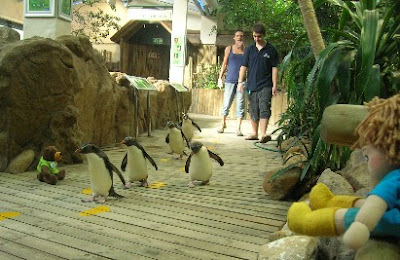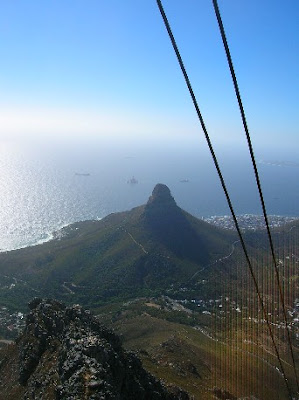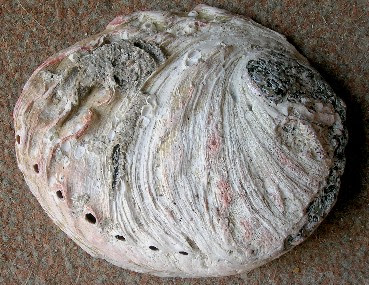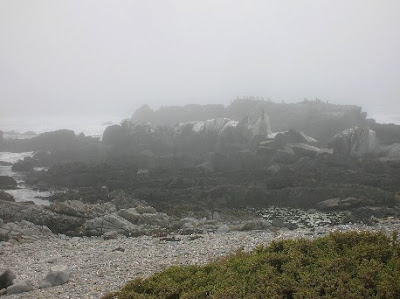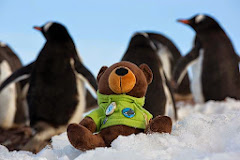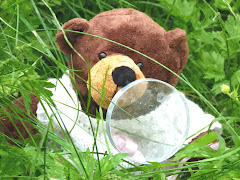Thursday 26 January 2012
Farewell to Abby, but not to South Africa.
Hi all
I have had loads of fun here with Abby but sadly its time to leave. Abby is travelling back to the USA to the Prince William Sound Science Centre at a place called Cordova.
I must be on my way as well. I am going to be a student for a while as I have been invited to attend the annual Maritime and Underwater Cultural Heritage Field School here in South Africa. I will be travelling to Robben Island which is just off the coast. Jonathan, a very good friend of Ken Stewart (who I met when I visited the NABS Youth Summit a couple of years ago) heard from Ken that I was in South Africa. He told Jonathan that I was very interested in learning more about how we are all linked by Heritage and Culture. Jonathan very kindly organised a place for me on the training course.
There is a link below to my 5 days trip to the Youth Summit in 2010. http://adventuresofedthebear.blogspot.com/2010/07/ed-arrives-at-nabs-yes-and-makes-some.html
I have been invited again this year and I hope to catch up with my special friends, so keep an eye out for this in June.
Before I left, I gave Abby a small present, a special pebble from my beach back at Shoreham by Sea in the UK. The pebble is what is left of a fossil sponge that was covered in flint millions of years ago. These fossil flint sponges erode (wear away) from the chalk cliffs and then get broken up by wave action which then leaves pebbles with holes in them. I put some string through the pebble so she could wear it as a necklace.
Abby had a gift for me as well. She gave me a special key ring from SANCCOB in the shape of a penguin – because she knew I loved seeing the penguins so much. Abby also gave me a piece of abalone shell that she had picked up during our first trip down to the rock pools.
Abby has promised to come and visit me in UK later in the year, I can’t wait it will be so much fun.
Bye for now, Ed the Bear and Abby.
I have had loads of fun here with Abby but sadly its time to leave. Abby is travelling back to the USA to the Prince William Sound Science Centre at a place called Cordova.
I must be on my way as well. I am going to be a student for a while as I have been invited to attend the annual Maritime and Underwater Cultural Heritage Field School here in South Africa. I will be travelling to Robben Island which is just off the coast. Jonathan, a very good friend of Ken Stewart (who I met when I visited the NABS Youth Summit a couple of years ago) heard from Ken that I was in South Africa. He told Jonathan that I was very interested in learning more about how we are all linked by Heritage and Culture. Jonathan very kindly organised a place for me on the training course.
There is a link below to my 5 days trip to the Youth Summit in 2010. http://adventuresofedthebear.blogspot.com/2010/07/ed-arrives-at-nabs-yes-and-makes-some.html
I have been invited again this year and I hope to catch up with my special friends, so keep an eye out for this in June.
Before I left, I gave Abby a small present, a special pebble from my beach back at Shoreham by Sea in the UK. The pebble is what is left of a fossil sponge that was covered in flint millions of years ago. These fossil flint sponges erode (wear away) from the chalk cliffs and then get broken up by wave action which then leaves pebbles with holes in them. I put some string through the pebble so she could wear it as a necklace.
Abby had a gift for me as well. She gave me a special key ring from SANCCOB in the shape of a penguin – because she knew I loved seeing the penguins so much. Abby also gave me a piece of abalone shell that she had picked up during our first trip down to the rock pools.
Abby has promised to come and visit me in UK later in the year, I can’t wait it will be so much fun.
Bye for now, Ed the Bear and Abby.
Wednesday 25 January 2012
Fishing Line Bins
Hi all
Abby took me to the beach a couple more times. I kept wanting to go back and see the penguins at Bolder Beach.
Abby showed me one of the 'Fishing Line Bins'that the Dyer Island Conservation Trust started in Gansbaai and are trying to get going around our coastline. The fishing line is dangerous to marine wildlife that can become entangled in the fishing line or accidentally swallow it.
Any used fishing line can be put in these bins and then it gets collected and the Trust is making a giant ball to see how much they can collect and then I think they're going to make recycled items out of the fishing line.
I explained to Abby that I had seen similar fishing line bins in Florida and that I thought they were an excellent idea. Every little piece of litter recycled is one less piece that ends up in the environment. See link below
http://adventuresofedthebear.blogspot.com/2010/05/responsible-fishing-in-florida-keys.html
Bye for now
Ed the Bear and Abby
Abby took me to the beach a couple more times. I kept wanting to go back and see the penguins at Bolder Beach.
Abby showed me one of the 'Fishing Line Bins'that the Dyer Island Conservation Trust started in Gansbaai and are trying to get going around our coastline. The fishing line is dangerous to marine wildlife that can become entangled in the fishing line or accidentally swallow it.
Any used fishing line can be put in these bins and then it gets collected and the Trust is making a giant ball to see how much they can collect and then I think they're going to make recycled items out of the fishing line.
I explained to Abby that I had seen similar fishing line bins in Florida and that I thought they were an excellent idea. Every little piece of litter recycled is one less piece that ends up in the environment. See link below
http://adventuresofedthebear.blogspot.com/2010/05/responsible-fishing-in-florida-keys.html
Bye for now
Ed the Bear and Abby
Tuesday 24 January 2012
Ed and Abby visit the Two Oceans Aquarium (part 2)
Hi everyone
Well here I am again to report on the rest of my visit to the Two Oceans Aquarium. Next we met Haley who looks after the African Penguins - just like the ones I saw at SANCCOB.
Hayley also started the "Rethink the bag" campaign.
This campaign is to get people to stop using plastic bags and to rather use re-usable material bags - plastic bags have been banned from the aquarium! I thought this was a great idea and I told Hayley about how I have been working on a similar project with schools in the UK
Hayley then told us a bit about the penguins.
We watched one of the volunteer staff clean the penguin pool
We then meet one of the penguins close up
This is Zuki, I had never been this close to a penguin before. I don't think Zuki had been this close to a bear either!
Then we watched the penguins being fed.
You can find out more about Zuki and the other African penguins on the link below.
http://www.aquarium.co.za/species_exhibits/browse_species/african_penguin/
African penguins are not the only penguins at the aquarium. There was also a small group of rock hopper penguins.
The rockhopper penguins were found stranded on southern Cape beaches and were rescued and looked after by the staff at SANCCOB. They cannot be released because of the risk of introducing diseases into wild populations . This is because rock hoppers are not usually found in South Africa. So they now live at the Two Oceans Aquarium
We watched the rock hopper penguins go past on their daily walk before going to the pool for a swim. They are very good at jumping from rock to rock which is why they are called rock hopper penguins.
Kevin, one of the aquarium staff, showed me one of the turtles he's busy caring for with the hope that it would be returned to the ocean. It came in very dehydrated and had wounds on its flippers but now it's fattened up and looking MUCH better.
I told Kevin about my trip to the Marathon Turtle Hospital in Florida which I visited in 2010. I also told him how one of the turtles I had seen there 'Scooter' who was well enough to be returned to the ocean just a few weeks ago (you can find out more on my link below).
http://adventuresofedthebear.blogspot.com/2012/01/scooter-returns-to-wild.html
We then looked around some more of the aquarium displays.
Then we watched this orange hermit crab. These crabs don't have hand shells on their back like most crabs so they live in empty seashells instead. When they grow too big, they have to find a new home. Fancy being able to carry around your house with you. That would mean you could live where ever you wanted to.
This strange looking shelled animal is a chiton. Its a type of snail but has a shell like woodlouse which bends at the joints so it can glide round corners. Cool. There are some bright red starfish as well.
This is a beautiful cold water sea anemone.
This huge tank has seaweeds as big as trees. This sea weed is called kelp and I saw a kelp forest in the USA where playful sea otters live.
Just before we left the aquarium we thanked all the staff for showing us around and telling us about all the different animals.
What a fantastic day.
See you soon
Ed the Bear and Abby
Well here I am again to report on the rest of my visit to the Two Oceans Aquarium. Next we met Haley who looks after the African Penguins - just like the ones I saw at SANCCOB.
Hayley also started the "Rethink the bag" campaign.
This campaign is to get people to stop using plastic bags and to rather use re-usable material bags - plastic bags have been banned from the aquarium! I thought this was a great idea and I told Hayley about how I have been working on a similar project with schools in the UK
Hayley then told us a bit about the penguins.
We watched one of the volunteer staff clean the penguin pool
We then meet one of the penguins close up
This is Zuki, I had never been this close to a penguin before. I don't think Zuki had been this close to a bear either!
Then we watched the penguins being fed.
You can find out more about Zuki and the other African penguins on the link below.
http://www.aquarium.co.za/species_exhibits/browse_species/african_penguin/
African penguins are not the only penguins at the aquarium. There was also a small group of rock hopper penguins.
The rockhopper penguins were found stranded on southern Cape beaches and were rescued and looked after by the staff at SANCCOB. They cannot be released because of the risk of introducing diseases into wild populations . This is because rock hoppers are not usually found in South Africa. So they now live at the Two Oceans Aquarium
We watched the rock hopper penguins go past on their daily walk before going to the pool for a swim. They are very good at jumping from rock to rock which is why they are called rock hopper penguins.
Next it was feeding time and we watched the rock hoppers being fed fish. Just like the African penguins they swallowed the fish whole and head first.
You can find out more about the rockhopper penguins on the link below
Kevin, one of the aquarium staff, showed me one of the turtles he's busy caring for with the hope that it would be returned to the ocean. It came in very dehydrated and had wounds on its flippers but now it's fattened up and looking MUCH better.
I told Kevin about my trip to the Marathon Turtle Hospital in Florida which I visited in 2010. I also told him how one of the turtles I had seen there 'Scooter' who was well enough to be returned to the ocean just a few weeks ago (you can find out more on my link below).
http://adventuresofedthebear.blogspot.com/2012/01/scooter-returns-to-wild.html
We then looked around some more of the aquarium displays.
I came face to face with this very large lobster.
This strange looking shelled animal is a chiton. Its a type of snail but has a shell like woodlouse which bends at the joints so it can glide round corners. Cool. There are some bright red starfish as well.
This is a beautiful cold water sea anemone.
This huge tank has seaweeds as big as trees. This sea weed is called kelp and I saw a kelp forest in the USA where playful sea otters live.
Just before we left the aquarium we thanked all the staff for showing us around and telling us about all the different animals.
What a fantastic day.
See you soon
Ed the Bear and Abby
Monday 23 January 2012
Ed and Abby visit the Two Oceans Aquarium (part 1)
Hi everyone
To find out more about the marine life that can be found off the coast of South Africa Abby took me to see the Two Oceans Aquarium in Cape Town. Abby explained that South Africa has coasts on both the Atlantic Ocean and Indian Ocean.
Ruth turned on the lights for the jellyfish display. Jellyfish are transparent which means you can see through them. The special lighting makes them show up.
These are box jellyfish and are very dangerous. They have tentacles with stingers to catch their prey. These jellyfish are much more dangerous than most jellyfish and they can even kill a person. I am glad that I am safely this side of the glass.
We moved along and came face to face with these starfish.
MORE PLASTIC POLLUTION PROBLEMS
The aquarium staff check every morning to see if there are any seals that need help. Many of the local seals end up with litter caught around their necks and the staff help to free them. The aquarium has even built a special platform where the seals can pull themselves out and sun themselves...and if they have litter around their necks or are hurt, they can be closed in with a gate and it makes it easier for the staff to help them.
http://www.aquarium.co.za/blog/entry/catching_up_with_the_aquariums_seal_rescue_team/
Later, Abby took me to met Dennis.
Dennis showed me some tiny plankton through the microscope. I explained to Dennis that I had helped NOAA studying plankton when I visited them in 2009.
I helped with the plankton sampling and also learned how climate change is causing the sea temperature to warm up which affects the plankton.
http://adventuresofedthebear.blogspot.com/2010/04/visit-to-coastal-discovery-center-in.html
How big whales ear plankton by filtering it from the water when I was whale watching with NOAA at the Channel Islands National Marine Sanctuary
http://adventuresofedthebear.blogspot.com/2010_07_01_archive.html
Dennis showed me how to use the microscope. I have used a small microscope before but this one was much bigger and more complex,
Dennis showed me lots of other things underneath the microscope which included barnacles and even some shark skin. Did you know they have tiny teeth on their skin called dermal denticles. They don’t use them to eat with but instead they are like a suit of armour and also help the shark to swim quickly and quietly.
More from my adventures in the aquarium in my next blog soon.
Bye for now
Ed the Bear and Abby
To find out more about the marine life that can be found off the coast of South Africa Abby took me to see the Two Oceans Aquarium in Cape Town. Abby explained that South Africa has coasts on both the Atlantic Ocean and Indian Ocean.
Abby is an aquarist (a person who is responsible for looking after the aquarium and the animals they care for).
Inside of the entrance to the aquarium was a large aquarium tank. Filled with big beautiful colourful fish. Abby knew lots of things about the marine life in the aquarium. We caught up with Ruth who was feeding some of the animals and cleaning the aquariums.Ruth turned on the lights for the jellyfish display. Jellyfish are transparent which means you can see through them. The special lighting makes them show up.
These are box jellyfish and are very dangerous. They have tentacles with stingers to catch their prey. These jellyfish are much more dangerous than most jellyfish and they can even kill a person. I am glad that I am safely this side of the glass.
We moved along and came face to face with these starfish.
MORE PLASTIC POLLUTION PROBLEMS
The aquarium staff check every morning to see if there are any seals that need help. Many of the local seals end up with litter caught around their necks and the staff help to free them. The aquarium has even built a special platform where the seals can pull themselves out and sun themselves...and if they have litter around their necks or are hurt, they can be closed in with a gate and it makes it easier for the staff to help them.
Unfortunately, this morning, the seals weren't on the special platform, but Vince went out to help them anyway. We watched from a distance. These are Cape fur seals.
When they seals moved we could see with binoculars that 2 seals had plastic bands around their necks. Vince tried to catch the seals to remove the plastic but because they were not on the special platform they were too tricky to catch. Vince said he would try again later.
He said the seals are very playful and inquisitive and they play with the plastic but when they put their head through the plastic hoops the hoops get stuck and eventually the plastic would cause injury and even death of the seal.
When we got back inside Vince showed us a pile of plastic.
He said that that all this plastic was removed from seals in just one week. Both Abby and I thought this was terrible, imagine how big the pile would be at the end of the year!
You can find out more about the problem of seals and plastic entanglement below.
http://www.aquarium.co.za/blog/entry/catching_up_with_the_aquariums_seal_rescue_team/
Later, Abby took me to met Dennis.
Dennis showed me some tiny plankton through the microscope. I explained to Dennis that I had helped NOAA studying plankton when I visited them in 2009.
I helped with the plankton sampling and also learned how climate change is causing the sea temperature to warm up which affects the plankton.
http://adventuresofedthebear.blogspot.com/2010/04/visit-to-coastal-discovery-center-in.html
How big whales ear plankton by filtering it from the water when I was whale watching with NOAA at the Channel Islands National Marine Sanctuary
http://adventuresofedthebear.blogspot.com/2010_07_01_archive.html
Dennis showed me how to use the microscope. I have used a small microscope before but this one was much bigger and more complex,
Dennis showed me lots of other things underneath the microscope which included barnacles and even some shark skin. Did you know they have tiny teeth on their skin called dermal denticles. They don’t use them to eat with but instead they are like a suit of armour and also help the shark to swim quickly and quietly.
More from my adventures in the aquarium in my next blog soon.
Bye for now
Ed the Bear and Abby
Saturday 21 January 2012
Table mountain and seashells
Hi everyone
To get a good view of the surrounding area Abby took me to the top of Table Mountain. Instead of being pointed like most mountains, Table Mountain is flat 'like a table' with very steep cliffs.
This is a view from the cable car
From the top of the mountain we had a fabulous view. We were 1,086 metres (3,563 ft) above sea level.
This is a view of Cape Town and the harbour
This is a view of Camps Bay Beach and the 12 Apostles coastline.
Later on the beach we found seashells and other interesting objects.
These are some of the shells we found
Some sponge
This is a tiny crayfish tail.
We even found some love periwinkles in a rock pool.
My favourite was this beautiful abalone shell.
Inside it is very shiny and colourful. This smooth surface stops the live animal from damaging its soft body against the shell.
This is the top view. Can you see the row of holes. The abalone breathes through these holes.
We had a great day.
You can click on the link below to see the objects I found washed up on my beach back in the UK.
http://adventuresofedthebear.blogspot.com/2009/09/blog-post.html
Bye for now
Ed the Bear and Abby
To get a good view of the surrounding area Abby took me to the top of Table Mountain. Instead of being pointed like most mountains, Table Mountain is flat 'like a table' with very steep cliffs.
This is a view from the cable car
From the top of the mountain we had a fabulous view. We were 1,086 metres (3,563 ft) above sea level.
This is a view of Cape Town and the harbour
This is a view of Camps Bay Beach and the 12 Apostles coastline.
Later on the beach we found seashells and other interesting objects.
These are some of the shells we found
Some sponge
This is a tiny crayfish tail.
We even found some love periwinkles in a rock pool.
My favourite was this beautiful abalone shell.
Inside it is very shiny and colourful. This smooth surface stops the live animal from damaging its soft body against the shell.
This is the top view. Can you see the row of holes. The abalone breathes through these holes.
We had a great day.
You can click on the link below to see the objects I found washed up on my beach back in the UK.
http://adventuresofedthebear.blogspot.com/2009/09/blog-post.html
Bye for now
Ed the Bear and Abby
Thursday 19 January 2012
Ed and Abby visit SANCCOB.
Hi everyone
Today, Abby took me to visit a place called SANCCOB which means The Southern African Foundation for the Conservation of Coastal Birds. SANCCOB is a seabird rehabilitation centre where they look after injured and sick seabirds.
This is me and Abby arriving at SANCCOB where we were meet by a lady called Margaret who showed us around.
If the seabirds are well enough they are returned back to the ocean. Sometimes the bird is too ill or injured and would not be able to sure without help. When this happen the bird remains at SANCCOB so it can be cared for. More about that in a minute.
There are all sorts of sea birds here including cormorant, gulls and even penguins – yes penguins here in South Africa! I thought penguins only lived in places where there is ice and snow but Abby explained that wasn’t so. Some penguins also live and nest on the beach near here.
Margaret took us both on a special tour including places where visitors don't usually go. This is one of the volunteers feeding some sick penguins.
We also met a gull that was brought in by a family who had hand-raised him and now he was too much for them to handle. Baby birds imprint on their parents, its how they know who they are and learn from their parents until they are old enough to look after themselves.
Unfortunately when people hand rear birds the baby bird might imprints on them instead. This means if this bird were to be released into the wild it would be very confused about how to behave and how to get on with other gulls. It may also pester people knowing they are a source of food, which can be dangerous. This gull will have to stay at SANCCOB because he can't be released. Althought people are trying to help, when people find young birds they should take them to a special centre like SANCCOB where they can be looked after and not get imprinted on people. With luck, they will be released back into the wild one day.
Another volunteer, Jenny, allowed us to get up close during the feeding of "Home Pen". This is where they look after the birds that can't be released back into the wild. While people cannot go near the birds that the centre plans to release, these birds can be seen and help educate the public. People pay to go on the tours and this helps to pay for the running of the centre.
Here, Jenny is feeding Baby, a cormorant, who is also a resident in home pen.
Later Nola, the vet at SANCCOB, invited us to look at some blood samples from the penguins under the microscope.
They check the penguins' blood every week to check on their progress to make sure they're getting better. This is one way of making sure when they can release them back into the wild as soon as possible.
Margaret said that there was a terrible oil spill in 2000 when an iron ore tanker MV Treasure sank between Robben Island and Dassen Island. It released 1,300 tons of fuel oil and thousands of sea birds were polluted by the oil. SANCCOB played a big part in the rescue, cleaning and releasing of many marine birds. Great job! It must have been a terrible sight.
A big thank you to eevryone who showed me around and letting us get close up to many of the birds.
Abby said she would take me to Boulder beach were a large colony of penguins live and nest.
These African Penguins make their nests on the beach or in old burrows.
Both parents take it in turns sitting on their two eggs and it takes about 40 days until they hatch.
I loved seeing the penguins
You can find out more about the great work they do at SANCCOB by visiting their website at http://www.sanccob.co.za/?m=1
We have had such a busy and exciting day.
See you all soon
Bye for now
Ed the Bear and Abby
Today, Abby took me to visit a place called SANCCOB which means The Southern African Foundation for the Conservation of Coastal Birds. SANCCOB is a seabird rehabilitation centre where they look after injured and sick seabirds.
This is me and Abby arriving at SANCCOB where we were meet by a lady called Margaret who showed us around.
If the seabirds are well enough they are returned back to the ocean. Sometimes the bird is too ill or injured and would not be able to sure without help. When this happen the bird remains at SANCCOB so it can be cared for. More about that in a minute.
There are all sorts of sea birds here including cormorant, gulls and even penguins – yes penguins here in South Africa! I thought penguins only lived in places where there is ice and snow but Abby explained that wasn’t so. Some penguins also live and nest on the beach near here.
Margaret took us both on a special tour including places where visitors don't usually go. This is one of the volunteers feeding some sick penguins.
We also met a gull that was brought in by a family who had hand-raised him and now he was too much for them to handle. Baby birds imprint on their parents, its how they know who they are and learn from their parents until they are old enough to look after themselves.
Unfortunately when people hand rear birds the baby bird might imprints on them instead. This means if this bird were to be released into the wild it would be very confused about how to behave and how to get on with other gulls. It may also pester people knowing they are a source of food, which can be dangerous. This gull will have to stay at SANCCOB because he can't be released. Althought people are trying to help, when people find young birds they should take them to a special centre like SANCCOB where they can be looked after and not get imprinted on people. With luck, they will be released back into the wild one day.
Another volunteer, Jenny, allowed us to get up close during the feeding of "Home Pen". This is where they look after the birds that can't be released back into the wild. While people cannot go near the birds that the centre plans to release, these birds can be seen and help educate the public. People pay to go on the tours and this helps to pay for the running of the centre.
Here, Jenny is feeding Baby, a cormorant, who is also a resident in home pen.
Later Nola, the vet at SANCCOB, invited us to look at some blood samples from the penguins under the microscope.
They check the penguins' blood every week to check on their progress to make sure they're getting better. This is one way of making sure when they can release them back into the wild as soon as possible.
Margaret said that there was a terrible oil spill in 2000 when an iron ore tanker MV Treasure sank between Robben Island and Dassen Island. It released 1,300 tons of fuel oil and thousands of sea birds were polluted by the oil. SANCCOB played a big part in the rescue, cleaning and releasing of many marine birds. Great job! It must have been a terrible sight.
A big thank you to eevryone who showed me around and letting us get close up to many of the birds.
Abby said she would take me to Boulder beach were a large colony of penguins live and nest.
These African Penguins make their nests on the beach or in old burrows.
Both parents take it in turns sitting on their two eggs and it takes about 40 days until they hatch.
I loved seeing the penguins
You can find out more about the great work they do at SANCCOB by visiting their website at http://www.sanccob.co.za/?m=1
We have had such a busy and exciting day.
See you all soon
Bye for now
Ed the Bear and Abby
Tuesday 17 January 2012
Grotto Bay
Hi everyone
Today Abby took me to have a look at the rock pools in Grotto Bay. All of a sudden it got very foggy as a sea mist came in so we didn't get to see much of a view.
There were many fascinating plants growing on the rocks at the top of the beach. As you may remember, my beach back home has rare shingle plants growing on it (it’s a rare habitat called vegetated shingle) so I was very interested to see what plants we could find at Grotto Bay.
This is a succulent and looks a bit like the English stone crop that grows on my beach back home.
We were going to explore the rock pool but Abby said it would not be safe to go too far out onto the rocks.
I explored some pools close to the beach. There were a few small sea snails
I did get to do a bit of rock climbing.
Today Abby took me to have a look at the rock pools in Grotto Bay. All of a sudden it got very foggy as a sea mist came in so we didn't get to see much of a view.
There were many fascinating plants growing on the rocks at the top of the beach. As you may remember, my beach back home has rare shingle plants growing on it (it’s a rare habitat called vegetated shingle) so I was very interested to see what plants we could find at Grotto Bay.
This is a succulent and looks a bit like the English stone crop that grows on my beach back home.
We were going to explore the rock pool but Abby said it would not be safe to go too far out onto the rocks.
I explored some pools close to the beach. There were a few small sea snails
I did get to do a bit of rock climbing.
We saw the shapes of a group of cormorants on a rock surrounded by mist.
We were both disappointed that it was so misty and so we decided to go back.
Come back soon to find out where Abby takes me next.
Come back soon to find out where Abby takes me next.
Bye for now, Ed the Bear and Abby
Monday 16 January 2012
Ed arrives safely in South Africa
Hi everyone.
Yes you guessed it, I’m here in South Africa with Abby, well in the area known as Western Cape to be exact. I've never been to Africa before so I am very excited. As you can see on the map below, Africa is South of the UK.
Abby has been travelling the world too. Abby works in an aquarium here in Cape Town but she is also travelling the world to find out more about different jobs/careers in the marine field and is learning along the way about different animals, facilities and cultures.
She has her own weblog where she plans to tell everyone about the fantastic work these people do to educate people and help protect the oceans.
Abby has made a quick detour from her trip to Alaska to come back and show me around before she continues onto the US. You can follow Abby's adventures at http://abbysaquariumadventures.blogspot.com/
Abby showed me where we were on a map and then she showed me some of the places she hoped to take me to while I was here.
I can't wait to have a look around
Bye for now Ed the Bear and Abby
Yes you guessed it, I’m here in South Africa with Abby, well in the area known as Western Cape to be exact. I've never been to Africa before so I am very excited. As you can see on the map below, Africa is South of the UK.
Abby has been travelling the world too. Abby works in an aquarium here in Cape Town but she is also travelling the world to find out more about different jobs/careers in the marine field and is learning along the way about different animals, facilities and cultures.
She has her own weblog where she plans to tell everyone about the fantastic work these people do to educate people and help protect the oceans.
Abby has made a quick detour from her trip to Alaska to come back and show me around before she continues onto the US. You can follow Abby's adventures at http://abbysaquariumadventures.blogspot.com/
Abby showed me where we were on a map and then she showed me some of the places she hoped to take me to while I was here.
I can't wait to have a look around
Bye for now Ed the Bear and Abby
Subscribe to:
Posts (Atom)







